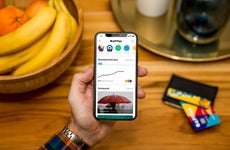The 6 best budgeting apps of 2024

The Bankrate promise
At Bankrate we strive to help you make smarter financial decisions. While we adhere to strict , this post may contain references to products from our partners. Here's an explanation for .
A budget can help you prepare for expenses, and with prices still high from lingering inflation, it’s especially important to track how much money is coming out of your bank account. Accounting for costs with a budget can help ensure necessary expenses are paid each month, build up savings and ease financial stress.
One tool that can help to track these expenses is likely just within reach: your mobile device. There are numerous budgeting apps available that come with enhanced features for tracking spending and boosting savings. See which features each app has to offer.
Key takeaways
- When choosing a budgeting app, it’s recommended to explore different options, read user reviews and consider trial versions to find the best fit for individual finances.
- Regularly reviewing the budget and spending data provided by the app can help users identify areas where money can be saved, which can then be used towards paying down debt, rebuilding an emergency fund or making investments.
- The Mint budgeting app will be discontinued by March 2024, with users encouraged to migrate to Credit Karma.
Best budgeting apps
Best for tracking spending: PocketGuard
If you find yourself constantly spending too much, an app that helps you easily understand how much money can be spent without having to build up credit-card debt is key. PocketGuard’s In My Pocket feature is designed to do just that by keeping a tab on how much spending money you have available after accounting for bills and other monthly necessities.
The app’s Insights tool breaks down where a user’s monthly income is spent into customizable categories, highlighting different spending habits. The tool has a top-merchants section that adds up all the money spent at a specific retailer each month. Insight into spending habits can motivate users to cut overspending and stick to their budgets.
PocketGuard also comes with a unique bill-tracking feature. Not only does it automatically identify monthly bills and organize them into categories, but it also helps users negotiate for better deals on certain bills. The bill negotiating service comes with no extra charge unless a bill is successfully lowered, in which case the app takes a 40 percent cut of the savings.
If you pay for PocketGuard Plus, you get some additional features, including a debt payoff plan. The debt payoff plan allows you to link accounts, such as credit card and loan accounts, and it then uses machine-learning algorithms to calculate a personalized debt repayment strategy.
Cost: Free for basic plan; Plus is $7.99 a month, $34.99 annually or $79.99 for a lifetime subscription.
Best for user-friendliness: You Need a Budget (YNAB)
One of the foundational rules of You Need a Budget is that you have to assign a job to every dollar you earn. So, rather than hoping to live with some percentage-based rules — 10 percent of your income going toward groceries, for example — you have to assign a plan for the money that comes in each month.
YNAB provides a centralized layout of users’ income and spending. In other words, account balances, loan debts and monthly bills are all displayed on a single page, where they can easily be tracked. Users can plan further ahead, too, and factor non-monthly bills into their budgets. It’s also possible to make shared budgets, where users can split bills and subscriptions with a partner, roommate or family member.
After the free trial, YNAB costs $14.99 a month. While there’s no free version of the service, it notes that users never have to worry about YNAB selling their data — the product is entirely paid for by users, with their data kept private.
Cost: Free for 34 days, then $14.99 a month or $99 annually.
Best for organizing funds: EveryDollar
EveryDollar brings some old-fashioned budgeting techniques and integrates them with more up-to-date technology. It organizes expenses into a classic spreadsheet, with each transaction amount and date listed, which can then be exported as a CSV file. By linking a user’s bank account, EveryDollar eases up some of the manual work of filling out a spreadsheet and automatically imports transactions from bank data.
Like many of the top budgeting apps, EveryDollar allows users to make custom spending categories and group similar expenses together.
Another helpful feature of EveryDollar is its calendar. Users are able to set due dates for the different line items of their budget and get a notification when a certain bill is due, so they can avoid missing payments.
The free version of EveryDollar includes customizable budget and savings fund features. By paying for Premium, users can connect their bank accounts, utilize automated recommendations and receive group financial coaching.
Cost: Free for basic plan; Premium is $17.99 a month or $79.99 annually after the 14-day free trial.
Best for envelope budgeting: Goodbudget
Goodbudget is based on the envelope budgeting method — an old-school approach to dividing cash into different envelopes for different expense categories — but it’s all digital. For each spending category, money can only be taken from the designated envelope, assigned in the app.
One unique way Goodbudget puts a spin on traditional envelope budgeting is by allowing multiple users in a household to sync budgets. With synced accounts, users can see money deducted from an envelope when another user in their household spends from it. A dedicated savings envelope can also help couples save for future goals, like buying a house.
The app is also a good tool for those carrying a lot of debt. It comes with a debt account where users can track their payoff progress and calculate how long it will take to be debt-free.
With the basic plan, users get 20 total virtual envelopes and can sync up to two devices. Paying for Goodbudget Plus gets you unlimited envelopes and up to five synced devices.
Cost: Free for basic plan; Plus is $8 a month or $70 annually.
Best for couples: Honeydue
Honeydue is designed for couples. While most budgeting apps allow you to link bank accounts to them and track them from the app, Honeydue takes it a step further by then organizing linked bank accounts into individual and joint accounts – a feature many with shared finances will appreciate.
Couples can set monthly household spending limits in customizable categories, as well as receive notifications when bills are due. These features can help partners collaboratively establish financial boundaries and makes it easier to manage shared financial responsibilities.
Communication is a vital component of any successful relationship, and Honeydue recognizes this by incorporating a built-in chat feature. Couples can easily discuss and clarify specific transactions, whether it’s coordinating shared expenses or addressing an unusual transaction.
The app and all its features are free to use, though it asks users for optional tips of $1 to $10.
Cost: Free
Best for worldwide access: Wally
If you’ve got financial accounts in different countries, making a budget and tracking expenses coming from abroad in foreign currencies becomes all the more complicated. Luckily, Wally is an app that comes with global capabilities: It’s compatible with accounts in 70 different countries.
Wally lets users connect an unlimited number of bank accounts in any currency, and then it automatically tracks money coming in and out of the accounts using artificial intelligence (AI) technology. It can predict when upcoming bills are due and notify users beforehand. And although much of the app is automated, users still have the ability to set up custom rules and manually adjust categories as needed.
With its integration of AI, Wally comes with its own AI chat service for financial assistance called WallyGPT. Built into the Wally app, WallyGPT offers insights and guidance for any questions users might have about specific financial terms, investment strategies and how to meet financial goals. For example, you could ask the service “How much should I save for a two-week vacation in Japan?” and it would offer you a breakdown of average prices and how much to save per month, incorporating your personal savings and income.
Cost: Free
What happened to the Mint app?
Effective March 2024, the Mint budgeting app will be discontinued, according to Intuit, the app’s parent company. Current users will be notified and encouraged to migrate to Credit Karma as part of a phased rollout.
Users migrating to Credit Karma can transfer essential data, including net worth history and transaction records. Note that Credit Karma doesn’t replicate all the budgeting features of Mint, but it has some similarities, such as providing insights into monthly spending broken down by category.
For Mint users who don’t want to migrate to Credit Karma, there’s an alternative option (other than just losing all data). They can get a copy of their Mint data by visiting the Mint site and selecting “Transactions.” Then, select “export transactions” and all transaction records will be exported to an Excel spreadsheet. (Note, though, that each download is limited to 10,000 transactions at a time.)
Users can also opt to delete their data by going to their Intuit account and selecting “data privacy.”
How to choose a budgeting app
With plentiful options available, choosing the right budgeting app means sifting through features and fees to get the best-fitted financial assistance. Here are some key considerations to keep in mind when comparing budgeting apps:
- Account connectivity
- Check whether the app allows you to connect all of your bank accounts.
- Automatic transaction categorization
- An up-to-date budgeting app should automatically categorize all of your transactions. This feature can help save time and provides insight into your spending patterns.
- Alerts and reminders
- You may want to look for an app that can alert you about upcoming bills, account balances and financial goal progress.
- Security and privacy
- Prioritize apps that adhere to high-security standards and are transparent about what they do with your data.
- Fees
- e aware of any fees associated with the app, such as subscription fees or fees charged for accessing certain premium features.
- Customer service
- Reliable customer support can be crucial when you encounter issues or have questions about the app’s functionality.
Take the time to explore different options, read user reviews and consider trial versions to find the app that suits your finances best.
You downloaded a budgeting app. Now what?
Budgeting apps allow users to divide spending into categories, but the creation of those categories falls on you. A good starting place is to make several categories for your largest monthly expenses, but avoid overwhelming yourself by creating too many subcategories.
To consistently work toward cutting spending and making progress toward savings goals, review your budget weekly, examine the spending data provided by the app and identify areas where money can be saved. Those savings can go toward paying down debt, rebuilding your emergency fund or investments.
Though it’s up to you to make good financial decisions, budgeting apps help to make those decisions easier.
Methodology
In selecting these budgeting apps, Bankrate looked for those that have diverse budgeting approaches, offering users a range of features to suit various preferences and financial goals. All chosen apps provide a free plan or offer a free trial, allowing users to explore features before committing. Automatic spending and transaction tracking were also a fundamental requirement for the apps on this list. The apps all have ratings of 3 or higher on the iOS App Store and the Google Play store, with the exception of Wally, which has a lower score for Google Play, but was included still for its innovation as a multi-currency budgeting app.
–Freelance writer David McMillin contributed to a previous version of this article.
Related Articles



